Building Applications, Opportunities and Challenges of Active Shading Systems: A State-of-the-Art Review
Abstract
1. Introduction
1.1. Passive versus Active Shading Systems in Buildings
1.2. Aim of the Review Paper and Objective
2. Active Shading Systems
2.1. Smart Glazing Systems
2.2. Kinetic External Shading Systems
2.2.1. Rotating Shading Systems
(a) Design Principle and Performance
(b) Material
(c) Carrier system of the shading device
2.2.2. Folding Shading Systems
(a) Design Principle and Performance
- Corrosion resistance.
- Durability (life cycle of the smart movement/shape memory effect)
- Stimulus responsiveness (solar radiation, outside air temperature, electrical stimulus)
- Workability (process and adaptability)
- Achievable movements
- Impressing force
(b) Material
- Shape change materials (SCMs) [106]: They are able to change their shape when right stimulus is present commonly a potential difference.
(c) Building Applications
- Translational movement which performs a bi-dimensional change of shape. It is linear and allows adjustment levels in the building skins by size-opening variation and by overlapping layers.
- Rotational movement which performs a tri-dimensional change of shape; and performs swivel motion both in the same axis and/or around a different axis.
2.3. Integration of Renewable Energy Systems
2.3.1. PV Integrated Shading Device
(a) Design Principle and Performance
(b) Building applications
2.3.2. Solar Collectors Integrated Shading Devices
(a) Design Principle and Performance
(b) Building applications
2.3.3. Algae Façade Systems
(a) Design principle
(b) System Performance
(c) Building applications
3. Controls of Active Shading Systems
3.1. User Control Shading Devices
3.2. Automatic Control Strategies
- Threshold controllers: where the shading device gets activated when an external solar illuminance or irradiance limit is exceeded.
- Sun blocking controllers: moves the shading system or adjust the blind slat angle depending on the sun position.
- Mode and scene controllers: use a variety of sensors and different control algorithms [30].
4. Challenges, Limitations and Future Opportunities in Active Shading Systems
5. Conclusions
- The use of electrochromic windows is increasing; however, its high cost is still a challenge.
- The electrochromic windows have always progressed in their performance and there is always an emergence of new types such as the NIR and POMs which have better performance. However, they are hindered by their high initial costs.
- The use of folding shading systems is still limited because of the need of expensive smart actuators and sensors.
- Rotating shading system is the most applied and studied system among active shading systems. Its low initial cost and available resources and materials including glass, metal, timber and fabric make it attractive.
- The use of automatic control strategies has been proven to be much more effective than the use of manual user controlled systems due to the benefits they provide including the adaptation to the external conditions.
- The use of robotic controlling systems and the thermo-hydraulic controlling systems are emerging automatic control systems that requires further investigation as there are limited number of studies done on their performance, building application and use in varying climate conditions.
- Additionally, more studies should be done on the integration of PV panels on this emerging type of shading devices.
Acknowledgments
Author Contributions
Conflicts of Interest
Nomenclature
| PV | Photovoltaic |
| SPDs | Suspended particle devices |
| EC | Electrochromic devices |
| LCD | Liquid crystal devices |
| LEDs | Light emitting diodes |
| CEC | Conventional electrochromic glazing |
| NEC | Near-infrared Switching Electrochromic |
| DBEC | Dual-band Electrochromic |
| PSBP | Polymer-stabilized Blue Phase |
| PDLC | Polymer-dispersed Liquid Crystal |
| LCoS | Liquid crystal on silicon displays |
| OILC | Optically isotropic LC |
| GDLC | Gel dispersed liquid crystals |
| AC | Alternating current |
| IR | Infra-red |
| SHGC | Solar heat gain coefficient |
| Tv | Visible transmission |
| SC | Shading coefficient |
| ITO | Indium tin oxide |
| IEQ | Indoor environmental quality |
| SRMs | Stimulus-responsive materials |
| SCMs | Shape change materials |
| SMMs | Shape memory materials |
| BIPV | Building integrated PV |
| BIST | Building-integrated solar thermal |
| IGU | Insulated glass unit |
References
- Boyce, P.; Hunter, C.; Howlett, O. The Benefits of Daylight through Windows; Rensselaer Polytechnic Institute: Troy, NY, USA, 2003. [Google Scholar]
- Tabet, A.K. Windows functions and design: Daylighting, visual comfort and well-being. In Proceedings of the CIE 2012, Lighting Quality and Energy Efficiency, Hangzhou, China, 19–21 September 2012; pp. 555–565. [Google Scholar]
- Edwards, L.; Torcellini, P.A. A Literature Review of the Effects of Natural Light on Building Occupants; National Renewable Energy Laboratory: Golden, CO, USA, 2002; p. 59. [Google Scholar]
- Veitch, J.A.; Galasiu, A.D. The Physiological and Psychological Effects of Windows, Daylight, and View at Home: Review and Research Agenda; National Research Council Canada: Ottawa, ON, Canada, 2012.
- Veitch, J.A.; Gifford, R. Assessing beliefs about lighting effects on health, performance, mood, and social behavior. Environ. Behav. 1996, 28, 446–470. [Google Scholar] [CrossRef]
- Figueiro, M.G. Daylight and productivity: A possible link to circadian regulation. In Proceedings of the 5th International LRO Lighting Research Symposium-Light and Human Hearth, Palo Alto, CA, USA, 3–5 November 2002; pp. 185–193. [Google Scholar]
- Mardaljevic, J.; Heschong, L.; Lee, E. Daylight metrics and energy savings. Light. Res. Technol. 2009, 41, 261–283. [Google Scholar] [CrossRef]
- Krarti, M.; Erickson, P.M.; Hillman, T.C. A simplified method to estimate energy savings of artificial lighting use from daylighting. Build. Environ. 2005, 40, 747–754. [Google Scholar] [CrossRef]
- Wienold, J. Dynamic daylight glare evaluation. In Proceedings of the Building Simulation, Glasgow, UK, 27–30 July 2009; pp. 944–951. [Google Scholar]
- Ander, G. Daylighting. Available online: http://www.wbdg.org/resources/daylighting (accessed on 8 June 2017).
- Kirimtat, A.; Koyunbaba, B.K.; Chatzikonstantinou, I.; Sariyildiz, S. Review of simulation modeling for shading devices in buildings. Renew. Sustain. Energy Rev. 2016, 53, 23–49. [Google Scholar] [CrossRef]
- Soflaei, F.; Shokouhian, M.; Abraveshdar, H.; Alipour, A. The impact of courtyard design variants on shading performance in hot-arid climates of Iran. Energy Build. 2017, 143, 71–83. [Google Scholar] [CrossRef]
- Michael, A.; Demosthenous, D.; Philokyprou, M. Natural ventilation for cooling in mediterranean climate: A case study in vernacular architecture of Cyprus. Energy Build. 2017, 144, 333–345. [Google Scholar] [CrossRef]
- Chandel, S.S.; Sharma, V.; Marwah, B.M. Review of energy efficient features in vernacular architecture for improving indoor thermal comfort conditions. Renew. Sustain. Energy Rev. 2016, 65, 459–477. [Google Scholar] [CrossRef]
- Kamarudin, Z. Long-roofed houses of northeastern peninsular Malaysia: Sustainability of its identity in the built environment. Procedia Environ. Sci. 2015, 28, 698–707. [Google Scholar] [CrossRef][Green Version]
- Al-Tamimi, N.; Fadzil, S.F.S. The Potential of Shading Devices for Temperature Reduction in High-Rise Residential Buildings in the Tropics. Procedia Eng. 2011, 21, 273–282. [Google Scholar] [CrossRef]
- Ebrahimpour, A.; Maerefat, M. Application of advanced glazing and overhangs in residential buildings. Energy Convers. Manag. 2011, 52, 212–219. [Google Scholar] [CrossRef]
- Tzempelikos, A.; Shen, H. Comparative control strategies for roller shades with respect to daylighting and energy performance. Build. Environ. 2013, 67, 179–192. [Google Scholar] [CrossRef]
- Tian, C.; Chen, T.; Chung, T.M. Experimental and simulating examination of computer tools, Radlink and DOE2, for daylighting and energy simulation with venetian blinds. Appl. Energy 2014, 124, 130–139. [Google Scholar] [CrossRef]
- Ye, Y.; Xu, P.; Mao, J.; Ji, Y. Experimental study on the effectiveness of internal shading devices. Energy Build. 2016, 111, 154–163. [Google Scholar] [CrossRef]
- Dutta, A.; Samanta, A.; Neogi, S. Influence of orientation and the impact of external window shading on building thermal performance in tropical climate. Energy Build. 2017, 139, 680–689. [Google Scholar] [CrossRef]
- Cho, J.; Yoo, C.; Kim, Y. Viability of exterior shading devices for high-rise residential buildings: Case study for cooling energy saving and economic feasibility analysis. Energy Build. 2014, 82, 771–785. [Google Scholar] [CrossRef]
- Karlsen, L.; Heiselberg, P.; Bryn, I.; Johra, H. Solar shading control strategy for office buildings in cold climate. Energy Build. 2016, 118, 316–328. [Google Scholar] [CrossRef]
- Aldawoud, A. Conventional fixed shading devices in comparison to an electrochromic glazing system in hot, dry climate. Energy Build. 2013, 59, 104–110. [Google Scholar] [CrossRef]
- Konstantoglou, M.; Tsangrassoulis, A. Dynamic operation of daylighting and shading systems: A literature review. Renew. Sustain. Energy Rev. 2016, 60, 268–283. [Google Scholar] [CrossRef]
- Lee, E.S.; Selkowitz, S.E.; Hughes, G.D.; Thurm, D.A. Market Transformation Opportunities for Emerging Dynamic Facade and Dimmable Lighting Control Systems; Lawrence Berkeley National Laboratory: Pacific Grove, CA, USA, 2004.
- Ibraheem, Y.; Farr, E.R.; Piroozfar, P.A. Embedding passive intelligence into building envelopes: A review of the state-of-the-art in integrated photovoltaic shading devices. Energy Procedia 2017, 111, 964–973. [Google Scholar] [CrossRef]
- Nielsen, M.V.; Svendsen, S.; Jensen, L.B. Quantifying the potential of automated dynamic solar shading in office buildings through integrated simulations of energy and daylight. Sol. Energy 2011, 85, 757–768. [Google Scholar] [CrossRef]
- Skaff, M.C.; Gosselin, L. Summer performance of ventilated windows with absorbing or smart glazings. Sol. Energy 2014, 105, 2–13. [Google Scholar] [CrossRef]
- Long, L.; Ye, H. Discussion of the performance improvement of thermochromic smart glazing applied in passive buildings. Sol. Energy 2014, 107, 236–244. [Google Scholar] [CrossRef]
- Rezaei, S.D.; Shannigrahi, S.; Ramakrishna, S. A review of conventional, advanced, and smart glazing technologies and materials for improving indoor environment. Sol. Energy Mater. Sol. Cells 2017, 159, 26–51. [Google Scholar] [CrossRef]
- Dussault, J.M.; Sourbron, M.; Gosselin, L. Reduced energy consumption and enhanced comfort with smart windows: Comparison between quasi-optimal, predictive and rule-based control strategies. Energy Build. 2016, 127, 680–691. [Google Scholar] [CrossRef]
- Allen, K.; Connelly, K.; Rutherford, P.; Wu, Y. Smart Windows—Dynamic Control of Building Energy Performance. Energy Build. 2017, 139, 535–546. [Google Scholar] [CrossRef]
- Lai, K.; Wang, W.; Giles, H. Solar shading performance of window with constant and dynamic shading function in different climate zones. Sol. Energy 2017, 147, 113–125. [Google Scholar] [CrossRef]
- Skarning, G.C.J.; Hviid, C.A.; Svendsen, S. The effect of dynamic solar shading on energy, daylighting and thermal comfort in a nearly zero-energy loft room in Rome and Copenhagen. Energy Build. 2017, 135, 302–311. [Google Scholar] [CrossRef]
- Manzan, M.; Clarich, A. FAST energy and daylight optimization of an office with fixed and movable shading devices. Build. Environ. 2017, 113, 175–184. [Google Scholar] [CrossRef]
- Linn, C. Kinetic Architecture: Design for Active Envelopes; Images Publishing: Victoria, Australia, 2014. [Google Scholar]
- Das, S.K.; Verma, D.; Nema, S.; Nema, R.K. Shading mitigation techniques: State-of-the-art in photovoltaic applications. Renew. Sustain. Energy Rev. 2017, 78, 369–390. [Google Scholar] [CrossRef]
- Loonen, R.; Trčka, M.; Cóstola, D.; Hensen, J. Climate adaptive building shells: State-of-the-art and future challenges. Renew. Sustain. Energy Rev. 2013, 25, 483–493. [Google Scholar] [CrossRef]
- Drozdowski, Z. The adaptive building initiative: The functional aesthetic of adaptivity. Archit. Des. 2011, 81, 118–123. [Google Scholar] [CrossRef]
- Mandalaki, M.; Zervas, K.; Tsoutsos, T.; Vazakas, A. Assessment of fixed shading devices with integrated PV for efficient energy use. Sol. Energy 2012, 86, 2561–2575. [Google Scholar] [CrossRef]
- Kim, K.H. Beyond Green: Growing Algae Facade. In Proceedings of the ARCC Conference Repository, Charlotte, NC, USA, 12–15 February 2014. [Google Scholar]
- Matuska, T.; Sourek, B. Façade solar collectors. Sol. Energy 2006, 80, 1443–1452. [Google Scholar] [CrossRef]
- Lampert, C.M. Smart switchable glazing for solar energy and daylight control. Sol. Energy Mater. Sol. Cells 1998, 52, 207–221. [Google Scholar] [CrossRef]
- Baetens, R.; Jelle, B.P.; Gustavsen, A. Properties, requirements and possibilities of smart windows for dynamic daylight and solar energy control in buildings: A state-of-the-art review. Sol. Energy Mater. Sol. Cells 2010, 94, 87–105. [Google Scholar] [CrossRef]
- Lee, E.S.; Tavil, A. Energy and visual comfort performance of electrochromic windows with overhangs. Build. Environ. 2007, 42, 2439–2449. [Google Scholar] [CrossRef]
- Loonen, M.R.C.G.; Singaravel, S.; Trčka, M.; Cóstola, D.; Hensen, J.L.M. Simulation-based support for product development of innovative building envelope components. Autom. Constr. 2014, 45, 86–95. [Google Scholar] [CrossRef]
- Barrios, D.; Vergaz, R.; Sanchez-Pena, J.M.; Garcia-Camara, B.; Granqvist, C.G.; Niklasson, G.A. Simulation of the thickness dependence of the optical properties of suspended particle devices. Sol. Energy Mater. Sol. Cells 2015, 143, 613–622. [Google Scholar] [CrossRef]
- Sottile, G.M. Assessment of attitudes and expectations of switchable glass among United States window manufacturers. In Proceedings of the Annual Technical Conference-Society Of Vacuum Coaters, Lake Buena Vista, FL, USA, 13–18 April 2002; pp. 163–169. [Google Scholar]
- Li, Z.; Ju, J.; Xu, W. Daylighting Control Performance and Subject Responses to Electrochromic Windows in a Meeting Room. Procedia Eng. 2015, 121, 27–32. [Google Scholar] [CrossRef]
- Miyatake, M.; Akahori, H.; Yoshimoto, S. Deformation of large liquid crystal display glass sheets across a gap between noncontact transportation devices. Precis. Eng. 2016, 46, 360–368. [Google Scholar] [CrossRef]
- Sbar, N.L.; Podbelski, L.; Yang, H.M.; Pease, B. Electrochromic dynamic windows for office buildings. Int. J. Sustain. Built Environ. 2012, 1, 125–139. [Google Scholar] [CrossRef]
- Lee, S.E.; DiBartolomeo, D.L. Application issues for large-area electrochromic windows in commercial buildings. Sol. Energy Mater. Sol. Cells 2002, 71, 465–491. [Google Scholar] [CrossRef]
- Chakrapani, S.; Slovak, S.M.; Saxe, R.L.; Fanning, B. SPD Films and Light Valves Comprising Same. U.S. Patent 6,416,827, 9 July 2002. [Google Scholar]
- Barrios Puerto, D. Characterization and Applications of New Electrochromic Devices: Comparison with Other Electrically Controllable Transmittance Technologies; Universidad Carlos III de Madrid: Madrid, Spain, 2012. [Google Scholar]
- Japan-Display LCD Basics. Available online: http://www.j-display.com/english/technology/lcdbasic.html (accessed on 20 June 2017).
- Gauza, S.; Zhu, X.; Piecek, W.; Dabrowski, R.; Wu, S.T. Fast switching liquid crystals for color-sequential LCDs. J. Disp. Technol. 2007, 3, 250–252. [Google Scholar] [CrossRef]
- DeForest, N.; Shehabi, A.; Selkowitz, S.; Milliron, D.J. A comparative energy analysis of three electrochromic glazing technologies in commercial and residential buildings. Appl. Energy 2017, 192, 95–109. [Google Scholar] [CrossRef]
- Runnerstrom, E.L.; Llordés, A.; Lounis, S.D.; Milliron, D.J. Nanostructured electrochromic smart windows: Traditional materials and NIR-selective plasmonic nanocrystals. Chem. Commun. 2014, 50, 10555–10572. [Google Scholar] [CrossRef] [PubMed]
- Korgel, B.A. Materials science: Composite for smarter windows. Nature 2013, 500, 278–279. [Google Scholar] [CrossRef] [PubMed]
- Ghosh, A.; Norton, B.; Duffy, A. Measured thermal performance of a combined suspended particle switchable device evacuated glazing. Appl. Energy 2016, 169, 469–480. [Google Scholar] [CrossRef]
- Cho, N.H.; Nayek, P.; Lee, J.J.; Lim, Y.J.; Lee, J.H.; Lee, S.H.; Park, H.S.; Lee, H.J.; Kim, H.S. High-performance, in-plane switching liquid crystal device utilizing an optically isotropic liquid crystal blend of nanostructured liquid crystal droplets in a polymer matrix. Mater. Lett. 2015, 153, 136–139. [Google Scholar] [CrossRef]
- Matsumoto, S.; Sugiyama, Y.; Sakata, S.; Hayashi, T. Electro-optic effect, propagation loss, and switching speed in polymers containing nano-sized droplets of liquid crystal. Liq. Cryst. 2000, 27, 649–655. [Google Scholar] [CrossRef]
- Lizana, A.; Moreno, I.; Márquez, A.; Lemmi, C.; Campos, J.; Yzuel, M.J. Influence of the temporal fluctuations phenomena on the ECB LCoS performance. In Proceedings of the SPIE Optical Engineering+ Applications, San Diego, CA, USA, 2–6 August 2009; International Society for Optics and Photonics: San Diego, CA, USA, 2009; p. 74420G. [Google Scholar]
- Granqvist, C.G. Electrochromic tungsten oxide films: Review of progress 1993–1998. Sol. Energy Mater. Sol. Cells 2000, 60, 201–262. [Google Scholar] [CrossRef]
- Piccolo, A. Thermal performance of an electrochromic smart window tested in an environmental test cell. Energy Build. 2010, 42, 1409–1417. [Google Scholar] [CrossRef]
- Block, M.; Bokalders, V. The Whole Building Handbook: How to Design Healthy, Efficient and Sustainable Buildings; Routledge: Abingdon, UK, 2010. [Google Scholar]
- Jelle, B.P. Solar radiation glazing factors for window panes, glass structures and electrochromic windows in buildings—Measurement and calculation. Sol. Energy Mater. Sol. Cells 2013, 116, 291–323. [Google Scholar] [CrossRef]
- Matthews, J.P.; Bell, J.M.; Skryabin, I.L. Simulation of electrochromic switching voltages at elevated temperatures. Electrochim. Acta 2001, 46, 1957–1961. [Google Scholar] [CrossRef]
- Baldassarri, C.; Shehabi, A.; Asdrubali, F.; Masanet, E. Energy and emissions analysis of next generation electrochromic devices. Sol. Energy Mater. Sol. Cells 2016, 156, 170–181. [Google Scholar] [CrossRef]
- Ghosh, A.; Norton, B.; Duffy, A. Measured overall heat transfer coefficient of a suspended particle device switchable glazing. Appl. Energy 2015, 159, 362–369. [Google Scholar] [CrossRef]
- Ghosh, A.; Norton, B.; Duffy, A. Behaviour of a SPD switchable glazing in an outdoor test cell with heat removal under varying weather conditions. Appl. Energy 2016, 180, 695–706. [Google Scholar] [CrossRef]
- Bloisi, F.; Vicari, L. Polymer-dispersed liquid crystals. In Optical Applications of Liquid Crystals; Taylor and Francis Group: Burlington, MA, USA, 2003; pp. 148–200. [Google Scholar]
- Collaborative, E.W. Liquid Crystal Device Windows. Available online: http://www.commercialwindows.org/liquidcrystal.php (accessed on 20 July 2017).
- Papaefthimiou, S.; Leftheriotis, G.; Yianoulis, P. Advanced electrochromic devices based on WO 3 thin films. Electrochim. Acta 2001, 46, 2145–2150. [Google Scholar] [CrossRef]
- Ghosh, A.; Norton, B.; Duffy, A. First outdoor characterisation of a PV powered suspended particle device switchable glazing. Sol. Energy Mater. Sol. Cells 2016, 157, 1–9. [Google Scholar] [CrossRef]
- Yan, J.; Li, Y.; Wu, S.T. High-efficiency and fast-response tunable phase grating using a blue phase liquid crystal. Opt. Lett. 2011, 36, 1404–1406. [Google Scholar] [CrossRef] [PubMed]
- Jung, D.; Choi, W.; Park, J.Y.; Kim, K.B.; Lee, N.; Seo, Y.; Kim, H.S.; Kong, N.K. Inorganic gel and liquid crystal based smart window using silica sol-gel process. Sol. Energy Mater. Sol. Cells 2017, 159, 488–495. [Google Scholar] [CrossRef]
- Khaligh, H.H.; Liew, K.; Han, Y.; Abukhdeir, N.M.; Goldthorpe, I.A. Silver nanowire transparent electrodes for liquid crystal-based smart windows. Sol. Energy Mater. Sol. Cells 2015, 132, 337–341. [Google Scholar] [CrossRef]
- Park, S.; Hong, J.W. Polymer dispersed liquid crystal film for variable-transparency glazing. Thin Solid Films 2009, 517, 3183–3186. [Google Scholar] [CrossRef]
- Selkowitz, S.E.; Rubin, M.; Lee, E.S.; Sullivan, R. A Review of electrochromic window performance factors. In Optical Materials Technology for Energy Efficiency and Solar Energy Conversion XIII; International Society for Optics and Photonics: Freiburg, Germany, 1994; pp. 226–248. [Google Scholar]
- Papaefthimiou, S.; Syrrakou, E.; Yianoulis, P. Energy performance assessment of an electrochromic window. Thin Solid Films 2006, 502, 257–264. [Google Scholar] [CrossRef]
- Cupelli, D.; Nicoletta, F.P.; Manfredi, S.; Vivacqua, M.; Formoso, P.; De Filpo, G.; Chidichimo, G. Self-adjusting smart windows based on polymer-dispersed liquid crystals. Sol. Energy Mater. Sol. Cells 2009, 93, 2008–2012. [Google Scholar] [CrossRef]
- DeForest, N.; Shehabi, A.; Garcia, G.; Greenblatt, J.; Masanet, E.; Lee, E.S.; Selkowitz, S.; Milliron, D.J. Regional performance targets for transparent near-infrared switching electrochromic window glazings. Build. Environ. 2013, 61, 160–168. [Google Scholar] [CrossRef]
- Lee, E. High Performance Building Facade Solutions; PIER Final Project Report; Lawrence Berkeley National Laboratory: Berkeley, CA, USA, 2011.
- Selkowitz, S.; Lee, E. Field Testing of Dynamic Façade Controls in Highly Glazed Buildings for Energy Efficiency and Comfort; Glass Processing Days: Tampere, Finland, 2005; pp. 557–561. [Google Scholar]
- Wigginton, M.; Harris, J. Intelligent Skins; Routledge: Oxford, UK, 2013. [Google Scholar]
- Schaeffer, O.; Vogt, M.-M. Move: Architecture in Motion-Dynamic Components and Elements; Walter de Gruyter: Berlin, Germany, 2010. [Google Scholar]
- Moloney, J. Designing Kinetics for Architectural Facades: State Change; Taylor & Francis: Abingdon, UK, 2011. [Google Scholar]
- Asefi, M. Transformable and Kinetic Architectural Structures: Design, Evaluation and Application to Intelligent Architecture; Dr. Müller: Liverpool, UK, 2010. [Google Scholar]
- Orsi, A. An Exploration of the Impact of Fixed Shading Device Geometry on Building Energy Performance; ProQuest: Ann Arbor, MI, USA, 2009. [Google Scholar]
- Laustsen, J.B.; Santos, I.D.; Svendsen, S.; Traberg-Borup, S.; Johnsen, K. Solar shading system based on daylight directing glass lamellas. In Proceedings of the NSB2008, 8th Symposium on Building Physics in the Nordic Countries: Symposium on Building Physics in the Nordic Countries, Copenhagen, Denmark, 16–18 June 2008; pp. 111–118. [Google Scholar]
- Hammad, F.; Abu-Hijleh, B. The energy savings potential of using dynamic external louvers in an office building. Energy Build. 2010, 42, 1888–1895. [Google Scholar] [CrossRef]
- Baldinelli, G. Double skin facades for warm climate regions: Analysis of a solution with an integrated movable shading system. Build. Environ. 2009, 44, 1107–1118. [Google Scholar] [CrossRef]
- Kensek, K.; Hansanuwat, R. Environment control systems for sustainable design: A methodology for testing, simulating and comparing kinetic facade systems. J. Creat. Sustain. Archit. Built Environ. 2011, 1, 27–46. [Google Scholar]
- COLT Group. Glass Rotating Shading System. Available online: http://www.coltgroup.com/european-commission-headquarters.html (accessed on 13 June 2017).
- COLT Group. Solar Shading System. Available online: http://www.colt.es/tl_files/pdf/Solar%20Shading/Maximising%20energy%20performance%20and%20productivity%20with%20solar%20shading.pdf (accessed on 20 June 2017).
- COLT Group. Metal Rotating Shading Device. Available online: http://www.coltgroup.com/zurich-airport.html (accessed on 13 June 2017).
- COLT Group. Maximizing Energy Performance and Productivity with Solar Shading. Available online: file:///C:/Users/D_Q.com/Downloads/Maximising%20energy%20performance%20and%20productivity%20with%20solar%20shading.pdf (accessed on 4 August 2017).
- COLT Group. Solar Shading Louver System. Available online: https://www.coltinfo.co.uk/files/pdf/UK/Shadoglass%20and%20Shadovoltaic%20solar%20shading%20systems.pdf (accessed on 20 June 2017).
- Kuribayashi, K.; Tsuchiya, K.; You, Z.; Tomus, D.; Umemoto, M.; Ito, T.; Sasaki, M. Self-deployable origami stent grafts as a biomedical application of Ni-rich TiNi shape memory alloy foil. Mater. Sci. Eng. A 2006, 419, 131–137. [Google Scholar] [CrossRef]
- Nishiyama, Y. Miura folding: Applying origami to space exploration. Int. J. Pure Appl. Math. 2012, 79, 269–279. [Google Scholar]
- Addington, D.M.; Schodek, D.L. Smart Materials and New Technologies: For the Architecture and Design Professions; Routledge: Oxford, UK, 2005. [Google Scholar]
- Otsuka, K.; Wayman, C. Mechanism of Shape Memory Effect and Superelasticity. Shape Memory Materials. 1998, pp. 27–49. Available online: https://books.google.com.hk/books?hl=zh-CN&lr=&id=DvItE9XUlN8C&oi=fnd&pg=PR11&dq=In+Shape+Memory+Materials%3B+1998&ots=xk91Cbje_P&sig=xw3rvHHQcJI7CdLilMrLyPCQ4ks&redir_esc=y#v=onepage&q=In%20Shape%20Memory%20Materials%3B%201998&f=false (accessed on 20 September 2017).
- Trolier-McKinstry, S.; Newnham, R. Sensors, actuators, and smart materials. MRS Bull. 1993, 18, 27–33. [Google Scholar] [CrossRef]
- Fiorito, F.; Sauchelli, M.; Arroyo, D.; Pesenti, M.; Imperadori, M.; Masera, G.; Ranzi, G. Shape morphing solar shadings: A review. Renew. Sustain. Energy Rev. 2016, 55, 863–884. [Google Scholar] [CrossRef]
- Sun, L.; Huang, W.M.; Ding, Z.; Zhao, Y.; Wang, C.C.; Purnawali, H.; Tang, C. Stimulus-responsive shape memory materials: A review. Mater. Des. 2012, 33, 577–640. [Google Scholar] [CrossRef]
- Otsuka, K.; Wayman, C.M. Shape Memory Materials; Cambridge University Press: Cambridge, UK, 1999. [Google Scholar]
- Lienhard, J.; Schleicher, S.; Poppinga, S.; Masselter, T.; Milwich, M.; Speck, T.; Knippers, J. Flectofin: A hingeless flapping mechanism inspired by nature. Bioinspir. Biomim. 2011, 6, 045001. [Google Scholar] [CrossRef] [PubMed]
- Suralkar, R. Solar Responsive Kinetic Facade Shading Systems inspired by plant movements in nature. In Proceedings of the Conference: People and Buildings held at the offices of Arup UK, London, UK, 23 September 2011. [Google Scholar]
- Archdaily One Ocean, Thematic Pavilion EXPO 2012/Soma. Available online: http://www.archdaily.com/236979/one-ocean-thematic-pavilion-expo-2012-soma (accessed on 29 August 2016).
- Payne, A.O.; Johnson, J.K. Firefly: Interactive prototypes for architectural design. Archit. Des. 2013, 83, 144–147. [Google Scholar] [CrossRef]
- Lignarolo, L.; Lelieveld, C.; Teuffel, P. Shape morphing wind-responsive facade systems realized with smart materials. In Proceedings of the International Adaptive Architecture Conference, London, UK, 3–5 March 2011; pp. 3–5. [Google Scholar]
- Kretzer, M.; Rossi, D. ShapeShift. Leonardo 2012, 45, 480–481. [Google Scholar] [CrossRef]
- Karamata, B.; Andersen, M. Concept, Design and Performance of a Shape Variable Mashrabiya as a Shading and Daylighting System for Arid Climates. In Proceedings of the 30th PLEA Conference-Sustainable Habitat for Developing Societies, Ahmedabad, India, 16–18 December 2014; pp. 344–351. [Google Scholar]
- Yoo, S.H.; Lee, E.T.; Lee, J. Building integrated photovoltaics: A Korean case study. Sol. Energy 1998, 64, 151–161. [Google Scholar] [CrossRef]
- Yoo, S.H.; Lee, E.T. Efficiency characteristic of building integrated photovoltaics as a shading device. Build. Environ. 2002, 37, 615–623. [Google Scholar] [CrossRef]
- Yoo, S.-H.; Manz, H. Available remodeling simulation for a BIPV as a shading device. Sol. Energy Mater. Sol. Cells 2011, 95, 394–397. [Google Scholar] [CrossRef]
- Alonso, J.; Diaz, V.; Hernandez, M.; Bercero, F.; Canizo, C.; Pou, I.; Mohedano, R.; Benitez, P.; Minano, J.C.; Luque, A. A new static concentrator PV module with bifacial cells for integration on facades: The PV VENETIAN store. In Proceedings of the Photovoltaic Specialists Conference, New Orleans, LA, USA, 19–24 May 2002; pp. 1584–1587. [Google Scholar]
- ElSayed, M.S. Optimizing thermal performance of building-integrated photovoltaics for upgrading informal urbanization. Energy Build. 2016, 116, 232–248. [Google Scholar] [CrossRef]
- Khedari, J.; Waewsak, J.; Supheng, W.; Hirunlabh, J. Experimental investigation of performance of a multi-purpose PV-slat window. Sol. Energy Mater. Sol. Cells 2004, 82, 431–445. [Google Scholar] [CrossRef]
- Priatman, J.; Soegihardjo, O.; Loekita, S. Towards Energy Efficient Facade Through Solar-powered Shading Device. Procedia Soc. Behav. Sci. 2015, 179, 266–275. [Google Scholar] [CrossRef]
- Kim, S.H.; Kim, I.T.; Choi, A.S.; Sung, M. Evaluation of optimized PV power generation and electrical lighting energy savings from the PV blind-integrated daylight responsive dimming system using LED lighting. Sol. Energy 2014, 107, 746–757. [Google Scholar] [CrossRef]
- Saranti, A.; Tsoutsos, T.; Mandalaki, M. Sustainable Energy Planning. Design Shading Devices with Integrated Photovoltaic Systems for Residential Housing Units. Procedia Eng. 2015, 123, 479–487. [Google Scholar] [CrossRef][Green Version]
- Stamatakis, A.; Mandalaki, M.; Tsoutsos, T. Multi-criteria analysis for PV integrated in shading devices for Mediterranean region. Energy Build. 2016, 117, 128–137. [Google Scholar] [CrossRef]
- Mandalaki, M.; Tsoutsos, T.; Papamanolis, N. Integrated PV in shading systems for Mediterranean countries: Balance between energy production and visual comfort. Energy Build. 2014, 77, 445–456. [Google Scholar] [CrossRef]
- Furundzic, A.K.; Kosoric, V.; Golic, K. Potential for reduction of CO2 emissions by integration of solar water heating systems on student dormitories through building refurbishment. Sustain. Cities Soc. 2012, 2, 50–62. [Google Scholar] [CrossRef]
- Probst, M.M.; Roecker, C. Towards an improved architectural quality of building integrated solar thermal systems (BIST). Sol. Energy 2007, 81, 1104–1116. [Google Scholar] [CrossRef]
- Zhai, X.Q.; Wang, R.Z.; Dai, Y.J.; Wu, J.Y.; Ma, Q. Experience on integration of solar thermal technologies with green buildings. Renew. Energy 2008, 33, 1904–1910. [Google Scholar] [CrossRef]
- Motte, F.; Notton, G.; Cristofari, C.; Canaletti, J.L. Design and modelling of a new patented thermal solar collector with high building integration. Appl. Energy 2013, 102, 631–639. [Google Scholar] [CrossRef]
- Abu-Zour, A.M.; Riffat, S.B.; Gillott, M. New design of solar collector integrated into solar louvres for efficient heat transfer. Appl. Therm. Eng. 2006, 26, 1876–1882. [Google Scholar] [CrossRef]
- Palmero-Marrero, A.I.; Oliveira, A.C. Evaluation of a solar thermal system using building louvre shading devices. Sol. Energy 2006, 80, 545–554. [Google Scholar] [CrossRef]
- Chou, D.C.; Chang, C.S.; Chang, J.C. Energy conservation using solar collectors integrated with building louver shading devices. Appl. Therm. Eng. 2016, 93, 1282–1294. [Google Scholar] [CrossRef]
- Saadatian, O.; Sopian, K.; Mat, S.B.; Elhab, B.; Lim, C.; Ruslan, M. Solar Collectors as Shading Devices for Kuala Lumpur, Malaysia. 2013. Available online: http://www.wseas.us/e-library/conferences/2012/Zlin/ENAGROBIO/ENAGROBIO-13.pdf (accessed on 20 September 2017).
- Maroy, K.; Carbonez, K.; Steeman, M.; Van Den Bossche, N. Assessing the thermal performance of insulating glass units with infrared thermography: Potential and limitations. Energy Build. 2017, 138, 175–192. [Google Scholar] [CrossRef]
- COLT Group. Solar-Leaf Bioreactor Façade. Available online: http://www.coltinfo.co.uk/files/pdf/UK/SolarLeaf%20bioreactor%20facade.pdf (accessed on 23 June 2017).
- Kim, H.K. Climate change: Sustainability performance of a Bio-facade for a retrofitted building. In Proceedings of the ARCC Conference Repository, University of North Carolina at Charlotte, Charlotte, NC, USA, 12–15 February 2014. [Google Scholar]
- Van Den Wymelenberg, K. Patterns of occupant interaction with window blinds: A literature review. Energy Build. 2012, 51, 165–176. [Google Scholar] [CrossRef]
- Frontczak, M.; Andersen, R.V.; Wargocki, P. Questionnaire survey on factors influencing comfort with indoor environmental quality in Danish housing. Build. Environ. 2012, 50, 56–64. [Google Scholar] [CrossRef]
- Inoue, T.; Kawase, T.; Ibamoto, T.; Takakusa, S.; Matsuo, Y. The development of an optimal control system for window shading devices based on investigations in office buildings. ASHRAE Trans. 1988, 94, 1034–1049. [Google Scholar]
- Sutter, Y.; Dumortier, D.; Fontoynont, M. The use of shading systems in VDU task offices: A pilot study. Energy Build. 2006, 38, 780–789. [Google Scholar] [CrossRef]
- Galasiu, A.D.; Veitch, J.A. Occupant preferences and satisfaction with the luminous environment and control systems in daylit offices: A literature review. Energy Build. 2006, 38, 728–742. [Google Scholar] [CrossRef]
- Reinhart, C.F.; Voss, K. Monitoring manual control of electric lighting and blinds. Light. Res. Technol. 2003, 35, 243–258. [Google Scholar] [CrossRef]
- Wienold, J. Dynamic simulation of blind control strategies for visual comfort and energy balance analysis. Build. Simul. 2007, 1197–1204. [Google Scholar]
- Bakker, L.G.; Hoes-van Oeffelen, E.C.M.; Loonen, R.C.G.M.; Hensen, J.L.M. User satisfaction and interaction with automated dynamic facades: A pilot study. Build. Environ. 2014, 78, 44–52. [Google Scholar] [CrossRef]
- Colaco, S.G.; Kurian, C.P.; George, V.I.; Colaco, A.M. Prospective techniques of effective daylight harvesting in commercial buildings by employing window glazing, dynamic shading devices and dimming control—A literature review. Build. Simul. 2008, 1, 279–289. [Google Scholar] [CrossRef]
- Escuyer, S.; Fontoynont, M. Lighting controls: A field study of office workers’ reactions. Light. Res. Technol. 2001, 33, 77–94. [Google Scholar] [CrossRef]
- Mahdavi, A.; Mohammadi, A.; Kabir, E.; Lambeva, L. Occupants’ operation of lighting and shading systems in office buildings. J. Build. Perform. Simul. 2008, 1, 57–65. [Google Scholar] [CrossRef]
- Skelly, M.; Wilkinson, M. The evolution of interactive facades: Improving automated blind control. Whole Life Perform. Facades 2001, 129–142. [Google Scholar]
- Vine, E.; Lee, E.; Clear, R.; DiBartolomeo, D.; Selkowitz, S. Office worker response to an automated venetian blind and electric lighting system: A pilot study. Energy Build. 1998, 28, 205–218. [Google Scholar] [CrossRef]
- Konstantoglou, M.; Tsangrassoulis, A. Dynamic building envelope system: A control strategy for enhancing daylighting quality and reducing energy consumption. In Proceedings of the Energy Forum Conference, Dubai, UAE, 22–24 October 2012; pp. 6–7. [Google Scholar]
- Tzempelikos, A.; Athienitis, A.K. The impact of shading design and control on building cooling and lighting demand. Sol. Energy 2007, 81, 369–382. [Google Scholar] [CrossRef]
- Papamichael, K.M.; Rubinstein, F.; Selkowitz, S.; Ward, G. The Integration of Operable Shading Systems and Electric Lighting Controls; Windows and Lighting Program; Lawrence Berkeley Laboratory: Berkeley, CA, USA, 1986.
- Bauer, M.; Geiginger, J.; Hegetschweiler, W.; Morel, N.; Sejkora, G.; Wurmsdobler, P. Delta: A Blind Controller Using Fuzzy Logic. 1996. Available online: https://infoscience.epfl.ch/record/121517 (accessed on 20 September 2017).
- Zawidzki, M. Dynamic shading of a building envelope based on rotating polarized film system controlled by one-dimensional cellular automata in regular tessellations (triangular, square and hexagonal). Adv. Eng. Inform. 2015, 29, 87–100. [Google Scholar] [CrossRef]
- Wei, Z.; Yiqun, W.; Menghui, S. Modeling and simulation of electric-hydraulic control system for bending roll system, Robotics, Automation and Mechatronics. In Proceedings of the 2008 IEEE Conference on Robotics, Automation and Mechatronics, Chengdu, China, 21–24 September 2008; pp. 661–664. [Google Scholar]
- COLT Group. Architectural Solutions, Solar Shading Systems. Available online: http://erra.com.tr/medya/gunes/solar-shading-systems.pdf (accessed on 23 June 2017).
- Gage, S.A.; Thorne, W. Edge monkeys-the design of habitat specific robots in buildings. Technoetic Arts 2005, 3, 169–179. [Google Scholar] [CrossRef]
- Tracy, C.E.; Zhang, J.G.; Benson, D.K.; Czanderna, A.W.; Deb, S.K. Accelerated durability testing of electrochromic windows. Electrochim. Acta 1999, 44, 3195–3202. [Google Scholar] [CrossRef]
- Lampert, C.M.; Agrawal, A.; Baertlien, C.; Nagai, J. Durability evaluation of electrochromic devices–an industry perspective. Sol. Energy Mater. Sol. Cells 1999, 56, 449–463. [Google Scholar] [CrossRef]
- Piccolo, A.; Simone, F. Performance requirements for electrochromic smart window. J. Build. Eng. 2015, 3, 94–103. [Google Scholar] [CrossRef]
- Pesenti, M.; Masera, G.; Fiorito, F. Shaping an Origami shading device through visual and thermal simulations. Energy Procedia 2015, 78, 346–351. [Google Scholar] [CrossRef]
- Jelle, B.P.; Breivik, C.; Røkenes, H.D. Building integrated photovoltaic products: A state-of-the-art review and future research opportunities. Sol. Energy Mater. Sol. Cells 2012, 100, 69–96. [Google Scholar] [CrossRef]
- Hay, M. Hamburg Now Has an Algae Powered Building. Available online: https://www.good.is/articles/algae-powered-building (accessed on 22 June 2017).
- Wallis, D. When Algae on the Exterior Is a Good Thing. Available online: http://www.nytimes.com/2013/04/25/business/energy-environment/german-building-uses-algae-for-heating-and-cooling.html?_r=0 (accessed on 24 June 2017).
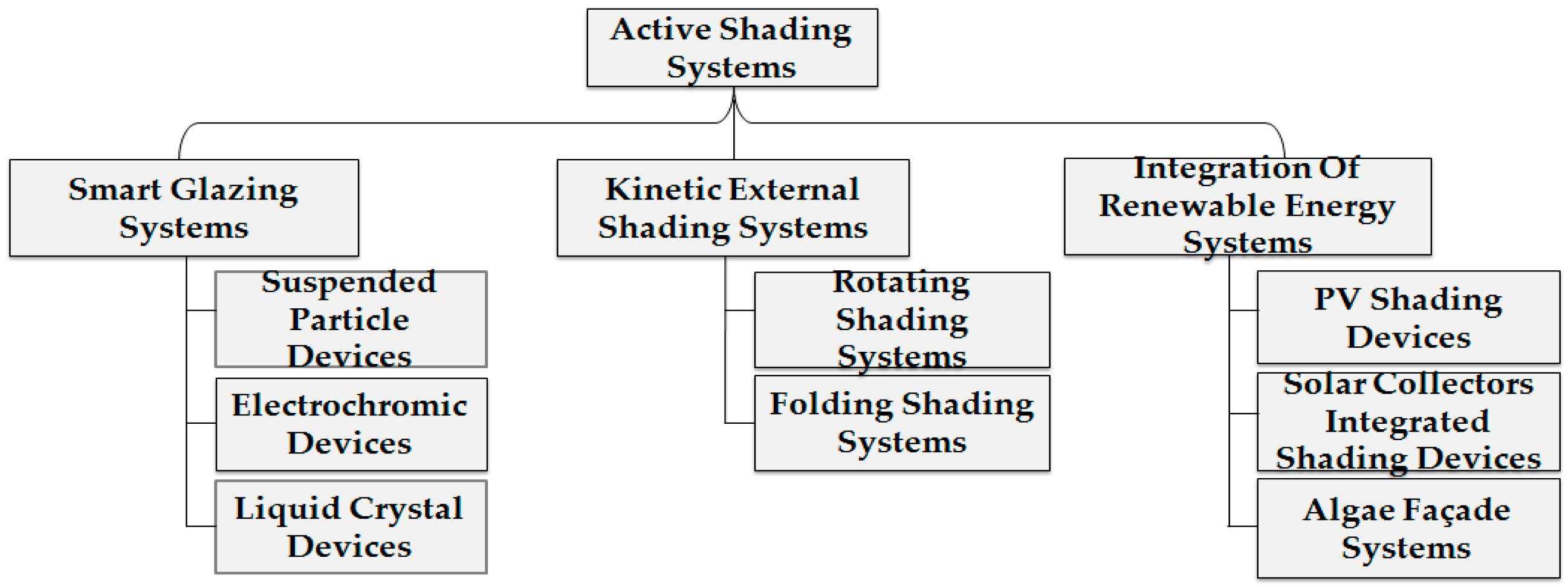

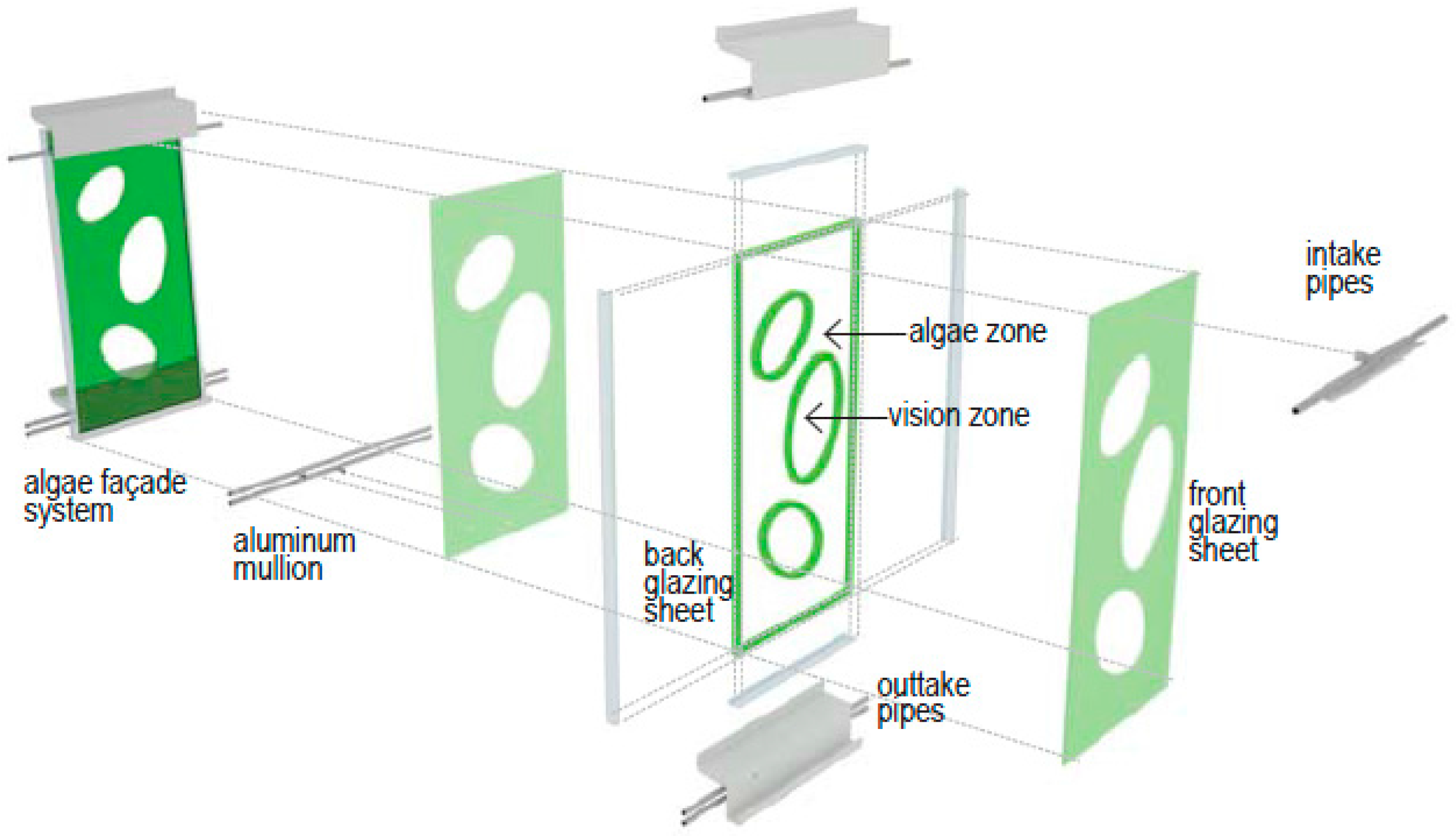
| System | Electrochromic Glazing (EC) | Suspended Particle Devices (SPDs) | Liquid Crystal Devices (LCDs) |
|---|---|---|---|
| Design Principle | |||
| Types and Materials |
| ||
| Working Mechanism |
|
|
|
| Composition Diagram | 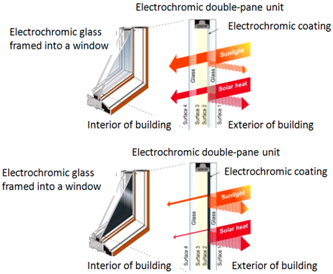 [52] Reproduced with permission from Elsevier and Copyright Clearance Center, 2017. | 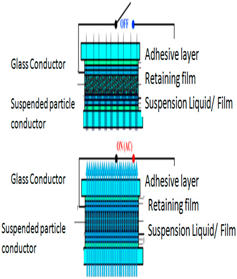 SPD in “off” and “on” states [48] Reproduced with permission from Elsevier and Copyright Clearance Center, 2017. | 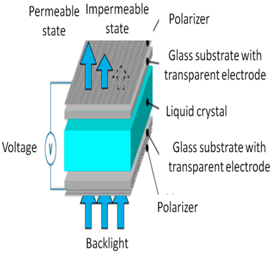 [56] Reproduced with the permission from Japan Display Inc, 2017. |
| Special Features |
|
|
|
| Benefits |
|
|
| Parameters | Performance of EC | Performance of SPDs | Performance of LCDs |
|---|---|---|---|
| Variable addressed |
|
|
|
| Cold climatic conditions |
|
|
|
| Variable addressed |
|
|
|
| Warm and hot climatic conditions |
|
| |
| Variable addressed |
| - | - |
| Mixed climatic conditions |
| - | - |
| Material | Glass Rotating Shading System [96,97] Reproduced with the Permission from COLT Company, 2017. |
| Building application example |  European Commission Headquarters, Brussels |
| Shading system design description | The façade was renovated using glass rotating systems which respond to the changes in light intensity and temperature. It is a solar-controlled glass with high reflectance coatings. |
| Benefits |
|
| Material | Metal rotating shading device [97,98] Reproduced with the permission from COLT company, 2017. |
| Building application example | 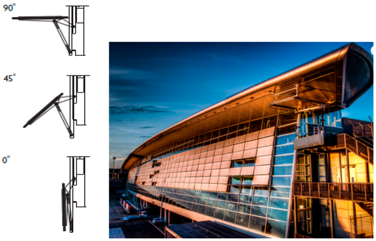 Zurich Airport, Switzerland |
| Shading system design description |
|
| Benefits |
|
| Material | Anodized aluminum shading device [99] Reproduced with the permission from COLT company, 2017. |
| Building application example | 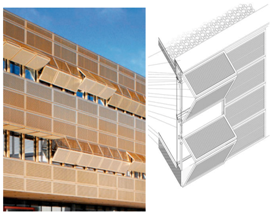 University of Potsdam, Germany |
| Shading system design description | Vertically folding shutters which open and closed according to the position of the sun. |
| Benefits |
|
| Carrier | Diagram | Description | Application |
|---|---|---|---|
| System 1: Straight carrier bracket [100] |  | Intended for wider spans, carrier system 1 incorporates a central aluminum torsion tube along the entire length of the louver, and is ideal for continuous facades, as well as for roofs. | Suitable for use with a variety of louver materials including glass, metal, fabric and timber wood.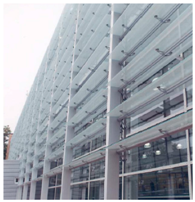 |
| System 2: Bracket carrier [100] | 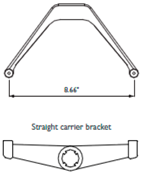 | Intended for shorter spans or where frequent anchor support points are available. It provides minimum obstruction from the louver so when used with glass louvers it maximizes the natural daylight and enhances the views to the outside. | Suitable for use with a variety of louver materials including glass, metal, fabric and timber wood. |
| System 3: Torsion bar carrier [100] |  | Like carrier system 1, carrier system 3 is intended for wider spans and incorporates a discreet central aluminum torsion tube along the entire length of the louver. It is ideal for continuous facades as well as for roofs. | Suitable for use with a variety of louver materials including glass, metal, fabric and timber wood.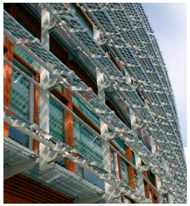 |
| System 4: Hung design carrier [100] |  | Carrier system 4 provides a back hung end pivoted solution with hidden control mechanisms integrated within the main vertical mullion supports. This allows for seamless continuous louvers with unobtrusive supports when viewed from the outside. | Suitable for use with a variety of louver materials including glass, metal, fabric and timber wood.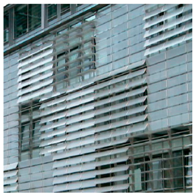 |
| System 5: Metal support clip [100] | 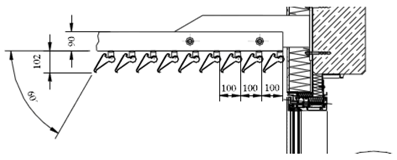 | The patented louver clip is adjustable in increments of 15 degrees. The plastic clip allows for thermal expansion of the blade and ensures that louver blades cannot rattle against the rafters. | Applied for metal louvers.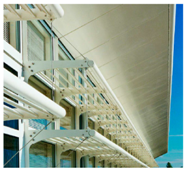 |
| Reference Study | Shape | Motion | Smart Actuator |
|---|---|---|---|
| Flectofin [109] | 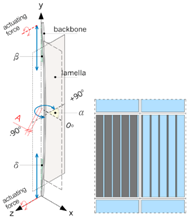 [106] [106] | Three-dimensional movement (swivel motion—Both in the same axis). | - |
| Solar Kinetic [110] | 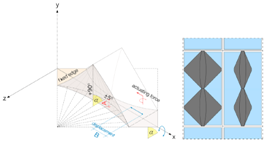 [106] [106] | Three-dimensional movement (swivel motion—Both in the same axis). | Shape Memory Alloys (SMA) |
| Ocean Thematic Pavilion [111] | 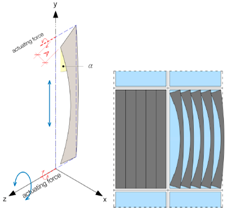 [106] [106] | Three-dimensional movement (swivel motion—around a different axis). | - |
| Air Flow [112] | 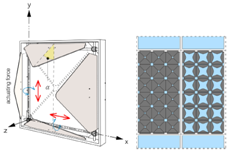 [106] [106] | Three-dimensional movement (swivel motion—around a different axis). | Shape Memory Alloys (SMA) |
| Sun Shading [113] | 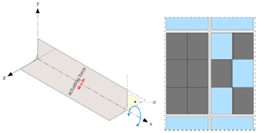 [106] [106] | Three-dimensional movement (swivel motion—around a different axis) | Shape Memory Alloys/ Shape Memory Polymers (SMA/SMP) |
| Smart Screen [114] | 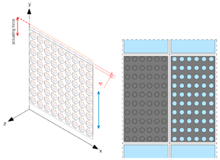 [106] [106] | Bi-Dimensional Movement (Translational Movement by overlapping layers) | Shape Memory Alloys (SMA) |
| Shape Variable Mashrabiya [115] | 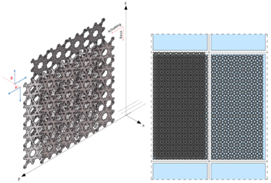 [106] Reproduced with permission from Elsevier and Copyright Clearance Center, 2017. [106] Reproduced with permission from Elsevier and Copyright Clearance Center, 2017. | Bi-Dimensional Movement (Translational Movement by overlapping layers) | Not Available (N/A) |
| Control Type | Description | Working Mechanism | Diagram |
|---|---|---|---|
| Non electrical thermo-hydraulic controlling system [156]. | A self sun-tracking device designed to control the external shading louvers. Controls the louvers without the use of electrical power or digital electronic devices [156,157]. | Consist of two fiber-reinforced polymer absorber tubes. The tubes are filled with special thermo-hydraulic fluid. When the sun moves, one tube is more irradiated to sun and heats up more than the other tube. This causes the hydraulic cylinder to move and rotate the louvers into optimal shading position throughout the day [156,157]. | 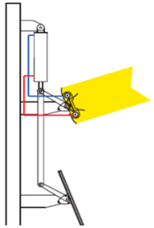 [157] Reproduced with the permission from COLT company, 2017. |
| Electrical controlling system [157] | The electric control operation adjustment of motors could be manual switches or automatic. Automatic controlled system consists of various sensors and has a fully controlling over the internal climate. | When the sun is direct, the motor sends data to the holder of the gear which is retracted and pulls smoothly the rod of the louvers downwards to close the louvers and block the sun. The sensors control the shading by rotating the louvers following the sun rotation. | 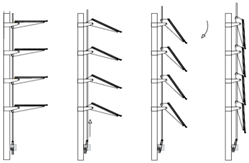 [129] Reproduced with the permission from COLT company, 2017. |
| Built robotic controlling system [158] Reproduced with the permission from authors Stephen Gage and William Thorne, 2017. | Hypothetical fleet of small robots called “Edge monkeys”. To protect building facades, regulate energy usage and indoor conditions. | These small robots could detect building facade, and regulate energy usage and indoor conditions in order to close windows, check thermostats, and adjust blinds. |  |
| Dynamic Shading Type | Challenges and Limitations | Opportunities and Development |
|---|---|---|
| Electrochromic Glazing |
|
|
| SPDs |
| |
| LCD |
|
|
| Folding shading systems |
| |
| PV mounted shading |
|
|
| Algae Façade System |
|
|
© 2017 by the authors. Licensee MDPI, Basel, Switzerland. This article is an open access article distributed under the terms and conditions of the Creative Commons Attribution (CC BY) license (http://creativecommons.org/licenses/by/4.0/).
Share and Cite
Al Dakheel, J.; Tabet Aoul, K. Building Applications, Opportunities and Challenges of Active Shading Systems: A State-of-the-Art Review. Energies 2017, 10, 1672. https://doi.org/10.3390/en10101672
Al Dakheel J, Tabet Aoul K. Building Applications, Opportunities and Challenges of Active Shading Systems: A State-of-the-Art Review. Energies. 2017; 10(10):1672. https://doi.org/10.3390/en10101672
Chicago/Turabian StyleAl Dakheel, Joud, and Kheira Tabet Aoul. 2017. "Building Applications, Opportunities and Challenges of Active Shading Systems: A State-of-the-Art Review" Energies 10, no. 10: 1672. https://doi.org/10.3390/en10101672
APA StyleAl Dakheel, J., & Tabet Aoul, K. (2017). Building Applications, Opportunities and Challenges of Active Shading Systems: A State-of-the-Art Review. Energies, 10(10), 1672. https://doi.org/10.3390/en10101672







